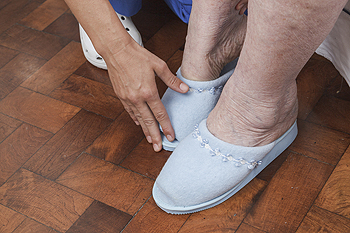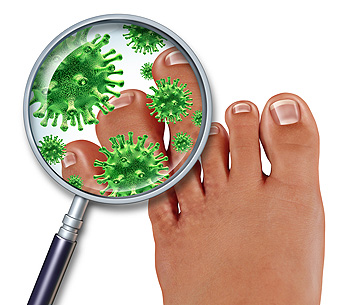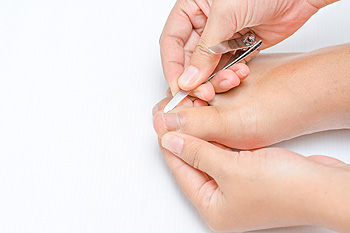Connect With Us
Blog
Items filtered by date: August 2018
Proper Care of Diabetic Feet
 If you are diabetic it’s important to learn how to properly take care of your feet. This may prevent possible infections that many diabetic patients may suffer from, and can ultimately lead to serious foot conditions. The importance of noticing cuts, bruises, or changes in the skin on the feet is crucial in maintaining good foot care. People who are diabetic are advised to wash and thoroughly dry their feet daily, wear socks and shoes as often as possible, and trimming the toenails correctly on a regular basis. When patients are active and can participate in a gentle exercise program, their feet may benefit in addition to positively affecting the overall health of the body. Please speak with a podiatrist as quickly as possible if you are diabetic. The podiatrist will be able to evaluate the general health of the feet.
If you are diabetic it’s important to learn how to properly take care of your feet. This may prevent possible infections that many diabetic patients may suffer from, and can ultimately lead to serious foot conditions. The importance of noticing cuts, bruises, or changes in the skin on the feet is crucial in maintaining good foot care. People who are diabetic are advised to wash and thoroughly dry their feet daily, wear socks and shoes as often as possible, and trimming the toenails correctly on a regular basis. When patients are active and can participate in a gentle exercise program, their feet may benefit in addition to positively affecting the overall health of the body. Please speak with a podiatrist as quickly as possible if you are diabetic. The podiatrist will be able to evaluate the general health of the feet.
Diabetic foot care is important in preventing foot ailments such as ulcers. If you are suffering from diabetes or have any other concerns about your feet, contact one of our podiatrists from Family Foot and Ankle Care of Moriches. Our doctors can provide the care you need to keep you pain-free and on your feet.
Diabetic Foot Care
Diabetes affects millions of people every year. The condition can damage blood vessels in many parts of the body, especially the feet. Because of this, taking care of your feet is essential if you have diabetes, and having a podiatrist help monitor your foot health is highly recommended.
The Importance of Caring for Your Feet
- Routinely inspect your feet for bruises or sores.
- Wear socks that fit your feet comfortably.
- Wear comfortable shoes that provide adequate support.
Patients with diabetes should have their doctor monitor their blood levels, as blood sugar levels play such a huge role in diabetic care. Monitoring these levels on a regular basis is highly advised.
It is always best to inform your healthcare professional of any concerns you may have regarding your feet, especially for diabetic patients. Early treatment and routine foot examinations are keys to maintaining proper health, especially because severe complications can arise if proper treatment is not applied.
If you have any questions please feel free to contact our offices located in Moriches and Shirley, NY . We offer the newest diagnostic and treatment technologies for all your foot and ankle needs.
Treating Athlete’s Foot
 Athlete’s foot, also known as tinea pedis, is a common fungal infection that can affect people who work out at public gyms. You can develop this condition by wearing tight, sweaty shoes for a long period of time or by walking barefoot on damp surfaces around your gym. This fungal infection is typically described as being itchy and scaly, and it can actually spread to other parts of the body. If you are looking for ways to avoid getting athlete’s foot, you should avoid walking barefoot at the gym, and opt to wear flip-flops instead. However, if you do get athlete’s foot, you may be able to treat it with over-the-counter fungal cream. If the cream doesn’t work for you, you may want to see your podiatrist to find a treatment option for your specific case.
Athlete’s foot, also known as tinea pedis, is a common fungal infection that can affect people who work out at public gyms. You can develop this condition by wearing tight, sweaty shoes for a long period of time or by walking barefoot on damp surfaces around your gym. This fungal infection is typically described as being itchy and scaly, and it can actually spread to other parts of the body. If you are looking for ways to avoid getting athlete’s foot, you should avoid walking barefoot at the gym, and opt to wear flip-flops instead. However, if you do get athlete’s foot, you may be able to treat it with over-the-counter fungal cream. If the cream doesn’t work for you, you may want to see your podiatrist to find a treatment option for your specific case.
Athlete’s Foot
Athlete’s foot is often an uncomfortable condition to experience. Thankfully, podiatrists specialize in treating athlete’s foot and offer the best treatment options. If you have any questions about athlete’s foot, consult with one of our podiatrists from Family Foot and Ankle Care of Moriches. Our doctors will assess your condition and provide you with quality treatment.
What Is Athlete’s Foot?
Tinea pedis, more commonly known as athlete’s foot, is a non-serious and common fungal infection of the foot. Athlete’s foot is contagious and can be contracted by touching someone who has it or infected surfaces. The most common places contaminated by it are public showers, locker rooms, and swimming pools. Once contracted, it grows on feet that are left inside moist, dark, and warm shoes and socks.
Prevention
The most effective ways to prevent athlete’s foot include:
- Thoroughly washing and drying feet
- Avoid going barefoot in locker rooms and public showers
- Using shower shoes in public showers
- Wearing socks that allow the feet to breathe
- Changing socks and shoes frequently if you sweat a lot
Symptoms
Athlete’s foot initially occurs as a rash between the toes. However, if left undiagnosed, it can spread to the sides and bottom of the feet, toenails, and if touched by hand, the hands themselves. Symptoms include:
- Redness
- Burning
- Itching
- Scaly and peeling skin
Diagnosis and Treatment
Diagnosis is quick and easy. Skin samples will be taken and either viewed under a microscope or sent to a lab for testing. Sometimes, a podiatrist can diagnose it based on simply looking at it. Once confirmed, treatment options include oral and topical antifungal medications.
If you have any questions, please feel free to contact our offices located in Moriches and Shirley, NY . We offer the newest diagnostic and treatment technologies for all your foot care needs.
What Causes Athlete’s Foot?
 There are several obvious symptoms that are associated with athlete’s foot, including itching, blisters, and cracked skin between the toes. Fortunately, moderate relief can be found with proper treatment. This condition is caused by a fungus, and it often thrives in warm and moist areas such as public pools, showers, and surrounding areas. It is known to be contagious, and it can be prevented by wearing appropriate shoes when visiting these areas. It may be beneficial to wear shoes that allow the feet to breathe in addition to wearing cotton socks that will aid in absorbing sweat. There are several treatment options available and it’s advised to consult with a podiatrist to determine which treatment is best for you.
There are several obvious symptoms that are associated with athlete’s foot, including itching, blisters, and cracked skin between the toes. Fortunately, moderate relief can be found with proper treatment. This condition is caused by a fungus, and it often thrives in warm and moist areas such as public pools, showers, and surrounding areas. It is known to be contagious, and it can be prevented by wearing appropriate shoes when visiting these areas. It may be beneficial to wear shoes that allow the feet to breathe in addition to wearing cotton socks that will aid in absorbing sweat. There are several treatment options available and it’s advised to consult with a podiatrist to determine which treatment is best for you.
Athlete’s foot is an inconvenient condition that can be easily reduced with the proper treatment. If you have any concerns about your feet and ankles, contact one of our podiatrists from Family Foot and Ankle Care of Moriches. Our doctors will treat your foot and ankle needs.
Athlete’s Foot: The Sole Story
Athlete's foot, also known as tinea pedis, can be an extremely contagious foot infection. It is commonly contracted in public changing areas and bathrooms, dormitory style living quarters, around locker rooms and public swimming pools, or anywhere your feet often come into contact with other people.
Solutions to Combat Athlete’s Foot
- Hydrate your feet by using lotion
- Exfoliate
- Buff off nails
- Use of anti-fungal products
- Examine your feet and visit your doctor if any suspicious blisters or cuts develop
Athlete’s foot can cause many irritating symptoms such as dry and flaking skin, itching, and redness. Some more severe symptoms can include bleeding and cracked skin, intense itching and burning, and even pain when walking. In the worst cases, Athlete’s foot can cause blistering as well. Speak to your podiatrist for a better understanding of the different causes of Athlete’s foot, as well as help in determining which treatment options are best for you.
If you have any questions please feel free to contact our offices located in Moriches and Shirley, NY . We offer the newest diagnostic and treatment technologies for all your foot and ankle needs.
Potential Dangers of Diabetic Feet
 Being aware of your feet is essential in managing diabetes. Many foot conditions can develop as a result of being diabetic, including bunions, corns, foot ulcers, and blisters. Possible nerve damage may occur as a result of elevated blood sugar levels, and this may encourage a condition that is referred to as diabetic neuropathy to develop. The symptoms of this ailment may include a loss of feeling in the feet, which may often lead to unnoticed cuts and bruises that may be present. Nerve damage may cause the feet to change shape, which indicates a different size shoe should be worn. If this is not adhered to, friction may cause unwanted foot conditions to develop. Cracked skin may often be a gateway for germs to enter the body, and this may be alleviated by utilizing a moisturizing cream or lotion. If you are diabetic, it’s vital to consult with a podiatrist as quickly as possible to learn about how to properly take care of your feet.
Being aware of your feet is essential in managing diabetes. Many foot conditions can develop as a result of being diabetic, including bunions, corns, foot ulcers, and blisters. Possible nerve damage may occur as a result of elevated blood sugar levels, and this may encourage a condition that is referred to as diabetic neuropathy to develop. The symptoms of this ailment may include a loss of feeling in the feet, which may often lead to unnoticed cuts and bruises that may be present. Nerve damage may cause the feet to change shape, which indicates a different size shoe should be worn. If this is not adhered to, friction may cause unwanted foot conditions to develop. Cracked skin may often be a gateway for germs to enter the body, and this may be alleviated by utilizing a moisturizing cream or lotion. If you are diabetic, it’s vital to consult with a podiatrist as quickly as possible to learn about how to properly take care of your feet.
Diabetic foot care is important in preventing foot ailments such as ulcers. If you are suffering from diabetes or have any other concerns about your feet, contact one of our podiatrists from Family Foot and Ankle Care of Moriches. Our doctors can provide the care you need to keep you pain-free and on your feet.
Diabetic Foot Care
Diabetes affects millions of people every year. The condition can damage blood vessels in many parts of the body, especially the feet. Because of this, taking care of your feet is essential if you have diabetes, and having a podiatrist help monitor your foot health is highly recommended.
The Importance of Caring for Your Feet
- Routinely inspect your feet for bruises or sores.
- Wear socks that fit your feet comfortably.
- Wear comfortable shoes that provide adequate support.
Patients with diabetes should have their doctor monitor their blood levels, as blood sugar levels play such a huge role in diabetic care. Monitoring these levels on a regular basis is highly advised.
It is always best to inform your healthcare professional of any concerns you may have regarding your feet, especially for diabetic patients. Early treatment and routine foot examinations are keys to maintaining proper health, especially because severe complications can arise if proper treatment is not applied.
If you have any questions please feel free to contact our offices located in Moriches and Shirley, NY . We offer the newest diagnostic and treatment technologies for all your foot and ankle needs.
Blog Archives
- March 2025
- February 2025
- January 2025
- December 2024
- November 2024
- October 2024
- September 2024
- August 2024
- July 2024
- June 2024
- May 2024
- April 2024
- March 2024
- February 2024
- January 2024
- December 2023
- November 2023
- October 2023
- September 2023
- August 2023
- July 2023
- June 2023
- May 2023
- April 2023
- March 2023
- February 2023
- January 2023
- December 2022
- November 2022
- October 2022
- September 2022
- August 2022
- July 2022
- June 2022
- May 2022
- April 2022
- March 2022
- February 2022
- January 2022
- December 2021
- November 2021
- October 2021
- September 2021
- August 2021
- July 2021
- June 2021
- May 2021
- April 2021
- March 2021
- February 2021
- January 2021
- December 2020
- November 2020
- October 2020
- September 2020
- August 2020
- July 2020
- June 2020
- May 2020
- April 2020
- March 2020
- February 2020
- January 2020
- December 2019
- November 2019
- October 2019
- September 2019
- August 2019
- July 2019
- June 2019
- May 2019
- April 2019
- March 2019
- February 2019
- January 2019
- December 2018
- November 2018
- October 2018
- September 2018
- August 2018
- July 2018
- June 2018
- May 2018
- April 2018
- March 2018
- February 2018
- January 2018
- December 2017
- November 2017
- October 2017
- September 2017
- August 2017
- July 2017
- June 2017
- May 2017
- April 2017
- March 2017
- February 2017
- January 2017
- December 2016
- November 2016
- October 2016
- September 2016
- August 2016
- July 2016
- June 2016
- October 2015
- September 2015
- August 2015
- July 2015
- June 2015
- May 2015
- April 2015



